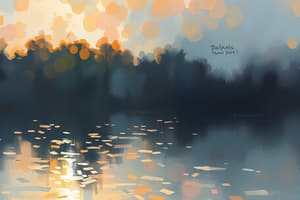Podcast
Questions and Answers
What is the role of emphasis in art?
What is the role of emphasis in art?
- To increase the overall size of the piece
- To direct the viewer's eye to a specific area (correct)
- To create contrasting colors
- To enhance the physical weight of the artwork
Which statement best describes the focal point in a work of art?
Which statement best describes the focal point in a work of art?
- It serves no significant purpose in composition.
- It is the area with the most vibrant colors.
- It is found only in paintings, not in other art forms.
- It is the main point of interest that captures viewer's attention. (correct)
What does balance in art achieve?
What does balance in art achieve?
- Eliminates the need for focal points
- Enhances the complexity of a single element
- Distributes weight for stability or equilibrium (correct)
- Creates a chaotic arrangement of elements
What does rhythm in art relate to?
What does rhythm in art relate to?
How is scale defined in relation to art?
How is scale defined in relation to art?
What best describes the concept of 'space' in art?
What best describes the concept of 'space' in art?
Which of the following best defines 'unity' in the principles of design?
Which of the following best defines 'unity' in the principles of design?
What differentiates positive space from negative space?
What differentiates positive space from negative space?
Which principle of design emphasizes the focal point in an artwork?
Which principle of design emphasizes the focal point in an artwork?
What characterizes kinetic art?
What characterizes kinetic art?
What is 'variety' in the context of design principles?
What is 'variety' in the context of design principles?
Texture in art can be described as:
Texture in art can be described as:
Which of the following statements about the principles of design is accurate?
Which of the following statements about the principles of design is accurate?
How does juxtaposition in art contribute to the viewer's experience?
How does juxtaposition in art contribute to the viewer's experience?
What is the primary effect of creating emphasis in an artwork?
What is the primary effect of creating emphasis in an artwork?
Which concept refers to the relationship of size among elements within a work of art?
Which concept refers to the relationship of size among elements within a work of art?
How does rhythm in art compare to music?
How does rhythm in art compare to music?
What aspect does balance in art primarily achieve?
What aspect does balance in art primarily achieve?
What is a key aspect of color theory for visual artists?
What is a key aspect of color theory for visual artists?
How can texture be represented in a work of art?
How can texture be represented in a work of art?
What is the significance of negative space in art?
What is the significance of negative space in art?
What distinguishes kinetic art from implied movement in art?
What distinguishes kinetic art from implied movement in art?
Which principle of design emphasizes creating a cohesive artwork?
Which principle of design emphasizes creating a cohesive artwork?
What does the principle of variety aim to achieve in a composition?
What does the principle of variety aim to achieve in a composition?
Which element describes the area that can be manipulated by an artist through placement of components?
Which element describes the area that can be manipulated by an artist through placement of components?
What is an outcome of effectively applying the principles of design?
What is an outcome of effectively applying the principles of design?
Flashcards are hidden until you start studying
Study Notes
Color
- Considered the most challenging element of art to define precisely.
- Perceived through descriptive words associated with different hues, such as red, blue, and yellow.
- Color theory categorizes and explains the qualities, behaviors, and effects of color for visual artists.
Texture
- Refers to the surface characteristics of materials, perceived by touch and sight.
- Can be inherent in the materials used or created through manipulation of surfaces.
- Implicit texture can be illustrated by realistic depictions of materials, like smooth silk or rough tree bark.
Space
- Describes the area surrounding or within components of art, referred to as "the breath of art" by Frank Lloyd Wright.
- Manipulated through the strategic placement of lines, shapes, forms, and colors.
- Includes two types:
- Positive space: the area occupied by the subject.
- Negative space: the area surrounding or between subjects.
Time and Motion
- Essential elements in art that involve change and movement over time and distance.
- Actual movement in art is termed Kinetic art.
- Illusory movements are referred to as implied motion.
Principles of Design
- Serve as visual strategies alongside elements of art to create effective artwork.
- Help clarify the artist’s message and provide compositional guidelines.
- Key principles include:
- Unity: Achieving cohesiveness and harmony among composition elements.
- Variety: Incorporating contrast and diversity to create interest and spontaneity.
- Emphasis: Highlighting particular areas to capture viewer attention.
- Focal Point: The primary point of interest in a piece of art.
- Balance: Distribution of visual weight for stability and equilibrium in design.
- Rhythm: Comparable to musical beat; involves patterns, movements, and flow.
- Scale: Measurement of size relative to human dimensions.
- Proportion: Comparative size of elements relative to each other or the entire work.
Artistic Freedom
- While applying elements and principles enhances artwork and message clarity, artistic creativity remains paramount.
- There is no singular "perfect" method for creating art; effectiveness is subject to individual artistic vision.
Color
- Considered the most challenging element of art to define precisely.
- Perceived through descriptive words associated with different hues, such as red, blue, and yellow.
- Color theory categorizes and explains the qualities, behaviors, and effects of color for visual artists.
Texture
- Refers to the surface characteristics of materials, perceived by touch and sight.
- Can be inherent in the materials used or created through manipulation of surfaces.
- Implicit texture can be illustrated by realistic depictions of materials, like smooth silk or rough tree bark.
Space
- Describes the area surrounding or within components of art, referred to as "the breath of art" by Frank Lloyd Wright.
- Manipulated through the strategic placement of lines, shapes, forms, and colors.
- Includes two types:
- Positive space: the area occupied by the subject.
- Negative space: the area surrounding or between subjects.
Time and Motion
- Essential elements in art that involve change and movement over time and distance.
- Actual movement in art is termed Kinetic art.
- Illusory movements are referred to as implied motion.
Principles of Design
- Serve as visual strategies alongside elements of art to create effective artwork.
- Help clarify the artist’s message and provide compositional guidelines.
- Key principles include:
- Unity: Achieving cohesiveness and harmony among composition elements.
- Variety: Incorporating contrast and diversity to create interest and spontaneity.
- Emphasis: Highlighting particular areas to capture viewer attention.
- Focal Point: The primary point of interest in a piece of art.
- Balance: Distribution of visual weight for stability and equilibrium in design.
- Rhythm: Comparable to musical beat; involves patterns, movements, and flow.
- Scale: Measurement of size relative to human dimensions.
- Proportion: Comparative size of elements relative to each other or the entire work.
Artistic Freedom
- While applying elements and principles enhances artwork and message clarity, artistic creativity remains paramount.
- There is no singular "perfect" method for creating art; effectiveness is subject to individual artistic vision.
Studying That Suits You
Use AI to generate personalized quizzes and flashcards to suit your learning preferences.




